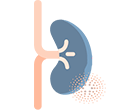Shah, O., Holmes, R. P., & Assimos, D. G. (n.d.). Management of patients with hyperoxaluria. Urinary Stone Disease, 103-119. doi:10.1007/978-1-59259-972-1_7
Hoppe, B., Beck, B. B., & Milliner, D. S. (2009). The primary hyperoxalurias. Kidney International, 75(12), 1264-1271. doi:10.1038/ki.2009.32
Filippova, T. V., Svetlichnaya, D. V., Rudenko, V. I., Alyaev, Y. G., Shumikhina, M. V., Azova, M. M., Subbotina, T. I., Gadzhieva, Z. K., Asanov, A. Y., & Litvinova, M. M. (2019). Urologiia (Moscow, Russia : 1999), (5), 140–143.
Milliner, D. (2006). Treatment of the primary hyperoxalurias: A new chapter. Kidney International, 70(7), 1198-1200. doi:10.1038/sj.ki.5001821
Straub, M., Hautmann, R. E., Hesse, A., & Rinnab, L. (2005). Kalciumoxalatharnsteine und hyperoxalurie. Der Urologe, 44(11), 1315-1323. doi:10.1007/s00120-005-0936-z





